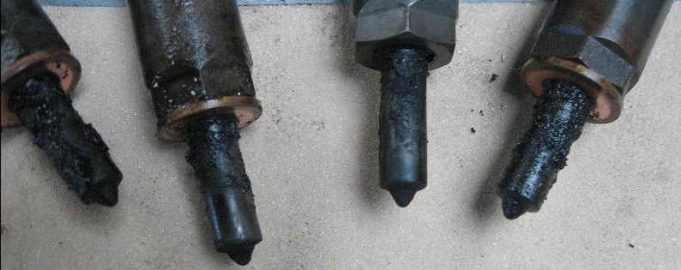Updated: March 2020
It’s Monday morning. You wake up bright and early, ready to start your day. You grab your coffee, kiss your wife goodbye, and head down to the car. As you turn the key, you hear the motor turn over. Instead of stumbling to life, it just cranks many more times than you’re used to.
 Second attempt. You give it a little throttle. It feels like the engine wants to turn over, but just doesn’t seem to catch.
Second attempt. You give it a little throttle. It feels like the engine wants to turn over, but just doesn’t seem to catch.
It takes a little effort, but the engine does eventually come to life. While driving to work, it feels as if the car is surging forward at random intervals. Is that gas you’re smelling? Does the exhaust usually smoke that much?
Symptoms like these wouldn’t commonly be associated with dirty fuel injectors. In most cases, carbon deposits in your fuel injection system are associated with a decline in performance, not a laundry list of deeply concerning problems. But there are a few ways that issues like this could crop up.
How to Clean a Clogged Fuel Injector
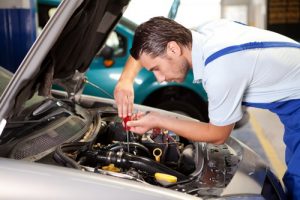
The easiest way to clean a clogged fuel injector? Fuel injector cleaner. It only costs $10-15 and we wrote up a great guide on how to pick the best one.
With some elbow grease and a little luck though, it shouldn’t be too hard to get your car back on the road, especially if it’s just dirty injectors or a single clogged fuel injector. If you’re reading this article, you’re likely well into the process of diagnosing the issue. But before you drive down to your local auto parts dealer, there are a few key steps you should take.
How to Tell If Your Fuel Injectors are Clogged?
Pouring some fuel injector cleaner down your gas tank is the quickest and easiest way to solve a clogged fuel injector – and it won’t harm your vehicle if there isn’t a clogged fuel injector and it’s a different problem. If anything, it probably will help. Here’s how to diagnose clogged fuel injectors.
1. Identify The Symptoms
On most modern vehicles, a clogged injector will prevent one of your cylinders from firing. Often, the car will still run. With a small four-cylinder engine, you’ll be able to tell that something is seriously wrong. With only three out of four cylinders firing, you’ll lose 25% of the vehicle’s power. On an 8 cylinder engine, a misfire won’t be as obvious. In fact, you’ll likely have no problem driving the vehicle, but this can be dangerous. In the long run, driving with a cylinder out can destroy an engine. But even though the severity of the impact is different, the core identifying factors are fairly consistent:
- Rough Idle – improper amount of fuel delivered
- Trouble or failure to start
- More exhaust from the tail pipe
- Smell of gas
- Engine misfire – improper air/fuel mixture
- Slow acceleration
- Decreased fuel economy
- Shaking felt through the steering wheel
- Stalling
If you have a few or all of these symptoms, you definitely have a misfire. But a clogged injector isn’t the only thing that could cause these exact set of problems.
Combustion requires three things: Fuel, Fire, and Pressure. This means that the misfire could also be caused by a failed spark plug, spark plug wires, cracked distributor, or a damaged seal.
A clogged fuel injector is the cheapest and easiest repair of all options, so it’s a great place to start. If you think you have one or more clogged fuel injectors, here’s the next steps to take.
Step 2: Diagnostics and Testing
If possible, start your car and let it run for about 15 minutes. Once it’s all warmed up, open the hook and look for the exhaust manifold. The exhaust is going to be extremely hot, so it’s essential that you do not touch it with your bare hand.
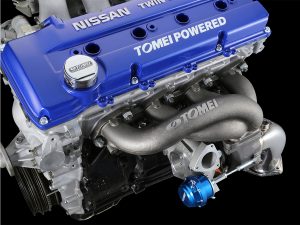
You can, however, hold the back of your hand a few inches away from the outlet of each cylinder to see if one of them is cooler than the others. If you can’t tell, you can get a heat marker from any automotive supply store. This looks like a large wax crayon inside a metal tube. When you touch it to the bare metal, the wax will change color depending on the temperature.
Now that you’ve found out which cylinder isn’t firing, you want to test the fuel injector to see if (and why) it’s malfunctioning and if you’ve got a clogged fuel injector. With a multimeter, check the wire to make sure there is voltage. You 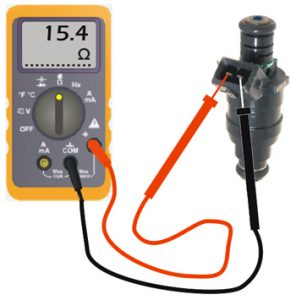 should also test the terminals of the fuel injector for resistance.
should also test the terminals of the fuel injector for resistance.
No voltage means that you have an electrical issue, and no resistance means that the injector has failed, as in you’ve got a clogged injector (or possibly some other problem)
Put the injector back in, but leave the wire disconnected. If you have the same symptoms as before, you can now determine that you’ve got a clogged fuel injector, and can move on to cleaning the injector. This test confirmed that your injector is mechanically functional and that you’ve identified the specific injector that is inoperable.
How to Unclog a Fuel Injector
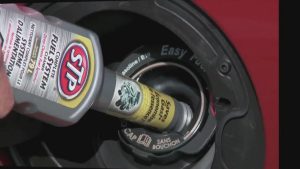 Okay, so now you’ve established you’ve got clogged fuel injectors, it’s time to clean it out. In order for this to work, your injector needs to have just a teeny bit of flow going through it. This may not be enough to fire the engine, but it can be enough to get some powerful detergent through.
Okay, so now you’ve established you’ve got clogged fuel injectors, it’s time to clean it out. In order for this to work, your injector needs to have just a teeny bit of flow going through it. This may not be enough to fire the engine, but it can be enough to get some powerful detergent through.
We wrote a guide that explains how to select and use fuel injector cleaners. Get the most powerful, concentrated option available and run a few bottles through. With luck, this may clear the clog. Just remember to read our guide fully, as these additives can’t fix every issue.
They work great for preventative maintenance, and they can fix problems if you catch them early enough. But if you have seriously neglected your vehicle, you may need professional help.
Still Have Symptoms? Might be time to Get Professional Help
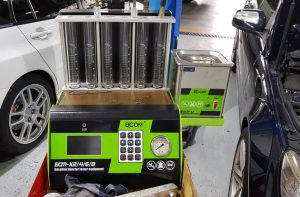
If cleaning your clogged fuel injectors yourself didn’t work, you’ll have to go to the professionals. Repair shops have highly specialized equipment that allows them to send solvents through the clogged fuel injectors at a very high pressure.
In some cases, your local mechanic may have to send it off. This equipment is expensive, so only shops that have a lot of traffic have it.
Fortunately, they can usually get it back within a few days, for much less than the cost of a new fuel injector. But if you want to get your car back on the road as soon as possible, replacing it might be the only option.
What Causes Injectors to Become Clogged?
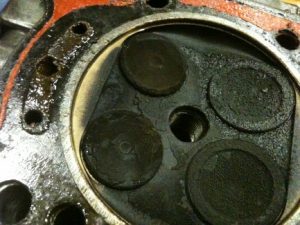 There are two possible reasons that you’ve got clogged fuel injectors. The most common issue is the buildup of carbon deposits. Carbon deposits are a side effect of combustion, consisting of hardened black material that gums up the fuel delivery path the same way that burgers can clog up your arteries. They are typically picked up and sequestered by your fuel filter, but not even the best fuel filter can stop an injector clogging up.
There are two possible reasons that you’ve got clogged fuel injectors. The most common issue is the buildup of carbon deposits. Carbon deposits are a side effect of combustion, consisting of hardened black material that gums up the fuel delivery path the same way that burgers can clog up your arteries. They are typically picked up and sequestered by your fuel filter, but not even the best fuel filter can stop an injector clogging up.
These buildups can affect the injection system directly, or your fuel system as a whole. Your engine is designed to function with a specific amount of fuel, and an optimal air/fuel mixture. The amount of fuel being delivered to your engine may be reduced by your fuel injectors if they get clogged. And you want nice, clean fuel injectors so that your engine performance is always at its peak.
Issues caused by carbon buildup don’t happen over night. When your car is properly maintained, carbon removed through normal operation of the car. Buildup will only become a clog when the vehicle has been neglected for a long period of time, and will be preceded by a slow and steady decrease in performance. After your injector cleaning, your fuel injectors should be operating properly, with the proper spray pattern and and giving the right amount of fuel to your fuel system.
 Another reason injectors can become clogged is due to poor quality fuel. If gas stations don’t clean out their tanks properly, dirt and sediment can settle on the bottom. This gunk can be picked up at the pump and run through your engine. Although this is less common, this is most likely to occur if you refuel your car at the same time as the gas station is filling their under ground tank. Gas flowing into the tank can stir up sediment and mix it around with the gas. Outside of this situation, stations typically have filters to keep sediment away from the pumps.
Another reason injectors can become clogged is due to poor quality fuel. If gas stations don’t clean out their tanks properly, dirt and sediment can settle on the bottom. This gunk can be picked up at the pump and run through your engine. Although this is less common, this is most likely to occur if you refuel your car at the same time as the gas station is filling their under ground tank. Gas flowing into the tank can stir up sediment and mix it around with the gas. Outside of this situation, stations typically have filters to keep sediment away from the pumps.
How to prevent your injector clogging at all? Get in the habit of using fuel injector cleaning solvents. It’s such a cheap and easy way to keep your fuel system running smoothly and efficiently.

